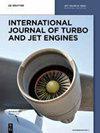An efficient flow control technique based on co-flow jet and multi-stage slot circulation control applied to a supercritical airfoil
IF 0.9
4区 工程技术
Q4 ENGINEERING, AEROSPACE
引用次数: 0
Abstract
Abstract Circulation control is a kind of efficient flow control technology which can improve aircraft aerodynamic performance and reduce fuel consumption. However, improving the aerodynamic efficiency of a circulation device to enhance flight endurance and achieve environmentally flying is a challenging problem for the application of circulation control. This paper presents an efficient flow control technique that combines co-flow jet and multi-stage slot circulation control. The combinational flow control technique is applied to a supersonic airfoil to test its energy consumption and aerodynamic benefit achievement. Results show that both the single and double slot circulation control can improve the maximum lift-drag ratio of the baseline airfoil, with an increment of 11.3% and 19.1%, respectively. Compared with the single application of co-flow jet control which can increase the lift-drag ratio of the baseline airfoil by 16.3% and extend the stall angle of attack from 6° to 8°, the combinational flow control can obtain a more significant lift-drag ratio increment by about 27.3% and eliminate flow separations at high angle of attack. The stall angle of attack can even be increased to about 10°. Additionally, the blowing efficiency of the circulation control airfoil has been comprehensively analyzed. The results show that the maximum effective lift-drag ratio and highest blowing efficiency can be achieved at a blowing coefficient of 0.00235.基于共流射流和多级缝隙循环控制的高效流动控制技术在超临界翼型中的应用
摘要循环控制是一种能够提高飞机气动性能、降低燃油消耗的高效流动控制技术。然而,如何提高循环装置的气动效率,提高飞行续航力,实现环境飞行,是循环控制应用中的一个难题。本文提出了一种将共流射流与多级槽式循环控制相结合的高效流动控制技术。将组合流动控制技术应用于某超声速翼型,对其能量消耗和气动效益进行了测试。结果表明,单缝和双缝循环控制均能提高基准翼型的最大升阻比,分别提高11.3%和19.1%。与单一应用共流射流控制可使基准翼型升阻比提高16.3%,失速攻角从6°扩展到8°相比,组合流动控制可获得更显著的升阻比增加约27.3%,并消除了大攻角下的流动分离。失速攻角甚至可以增加到10°左右。此外,还对循环控制翼型的吹气效率进行了综合分析。结果表明:吹气系数为0.00235时,有效升阻比最大,吹气效率最高;
本文章由计算机程序翻译,如有差异,请以英文原文为准。
求助全文
约1分钟内获得全文
求助全文
来源期刊

International Journal of Turbo & Jet-Engines
工程技术-工程:宇航
CiteScore
1.90
自引率
11.10%
发文量
36
审稿时长
6 months
期刊介绍:
The Main aim and scope of this Journal is to help improve each separate components R&D and superimpose separated results to get integrated systems by striving to reach the overall advanced design and benefits by integrating: (a) Physics, Aero, and Stealth Thermodynamics in simulations by flying unmanned or manned prototypes supported by integrated Computer Simulations based on: (b) Component R&D of: (i) Turbo and Jet-Engines, (ii) Airframe, (iii) Helmet-Aiming-Systems and Ammunition based on: (c) Anticipated New Programs Missions based on (d) IMPROVED RELIABILITY, DURABILITY, ECONOMICS, TACTICS, STRATEGIES and EDUCATION in both the civil and military domains of Turbo and Jet Engines.
The International Journal of Turbo & Jet Engines is devoted to cutting edge research in theory and design of propagation of jet aircraft. It serves as an international publication organ for new ideas, insights and results from industry and academic research on thermodynamics, combustion, behavior of related materials at high temperatures, turbine and engine design, thrust vectoring and flight control as well as energy and environmental issues.
 求助内容:
求助内容: 应助结果提醒方式:
应助结果提醒方式:


